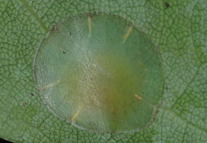Abstract
Austrolecanium cryptocaryae Lin & Cook sp. n. is described based on adult female morphology and DNA sequences from mitochondrial and nuclear loci. This Australian endemic species was found on the underside of leaves of Cryptocarya microneura (Lauraceae) in Queensland. All phylogenetic analyses of four independent DNA loci and a concatenated dataset show that A. cryptocaryae is monophyletic and closely related to A. sassafras Gullan & Hodgson, the type species of Austrolecanium Gullan & Hodgson. The adult female of A. cryptocaryae is described and illustrated and a table is provided of the characters that differ among adult females of the three species of Austrolecanium currently recognised (A. cappari (Froggatt), A. cryptocaryae sp. n. and A. sassafras).
References
Ben-Dov, Y. & Hodgson, C.J. (1997) 1.4 Techniques. In: Ben-Dov, Y. & Hodgson, C.J. (Eds.), Soft Scale Insects: Their Biology, Natural Enemies and Control. Vol. 7A. World Crop Pests. Elsevier Science B. V., Amsterdam, pp. 389–395.
https://doi.org/10.1016/S1572-4379(97)80067-XBrower, A.V.Z. & DeSalle, R. (1998) Patterns of mitochondrial versus nuclear DNA sequence divergence among nymphalid butterflies: the utility of wingless as a source of characters for phylogenetic inference. Insect Molecular Biology, 7, 73–82.
https://doi.org/10.1046/j.1365-2583.1998.71052.xCho, S., Mitchell, A., Regier, J.C., Mitter, C., Poole, R.W., Friedlander, T.P. & Zhao, S. (1995) A highly conserved nuclear gene for low-level phylogenetics: Elongation Factor-1α recovers morphology-based tree for heliothine moths. Molecular Biology and Evolution, 12, 650–656.
Darriba, D., Taboada, G.L., Doallo, R. & Posada, D. (2012) jModelTest 2: more models, new heuristics and parallel computing. Nature Methods, 9, 772.
Dowton, M. & Austin, A.D. (1998) Phylogenetic relationships among the microgastroid wasps (Hymenoptera: Braconidae): Combined analysis of 16S and 28S rDNA genes and morphological data. Molecular Phylogenetics and Evolution, 10, 354–366.
https://doi.org/10.1006/mpev.1998.0533Drummond, A. & Rambaut, A. (2006) Analysing BEAST Output. Available from: http://beast.bio.ed.ac.uk/analysing-beast-output (accessed 8 May 2016)
Drummond, A.J. & Rambaut, A. (2007) BEAST: Bayesian evolutionary analysis by sampling trees. BMC Evolutionary Biology, 7, 214.
https://doi.org/10.1186/1471-2148-7-214Folmer, O., Black, M., Hoeh, W., Lutz, R. & Vrijenhoek, R. (1994) DNA primers for amplification of mitochondrial cytochrome c oxidase subunit I from diverse metazoan invertebrates. Molecular Marine Biology and Biotechnology, 3, 294–299.
Froggatt, W.W. (1915) A descriptive catalogue of the scale insects ("Coccidae") of Australia. Agricultural Gazette of New South Wales, 26, 604–605.
Gullan, P.J. & Hodgson, C.J. (1998) A new genus of Australian soft scale insect (Hemiptera: Coccidae) with species on Capparis (Capparaceae) and Doryphora (Monimiaceae) from New South Wales. Proceedings of the Linnean Society of New South Wales, 119, 197–217.
Hardy, N.B., Gullan, P.J., Henderson, R.C. & Cook, L.G. (2008) Relationships among felt scale insects (Hemiptera: Coccoidea: Eriococcidae) of southern beech, Nothofagus (Nothofagaceae), with the first descriptions of Australian species of the Nothofagus-feeding genus Madarococcus Hoy. Invertebrate Systematics, 22, 365–405.
https://doi.org/10.1071/IS07032Hebert, P.D.N., Penton, E.H., Burns, J.M., Janzen, D.H. & Hallwachs, W. (2004) Ten species in one: DNA barcoding reveals cryptic species in the Neotropical skipper butterfly Astraptes fulgerator. Proceedings of the National Academy of Sciences of the United States of America, 101, 14812–14817.
https://doi.org/10.1073/pnas.0406166101Hillis, D.M. & Bull, J.J. (1993) An empirical test of bootstrapping as a method for assessing confidence in phylogenetic analysis. Systematic Biology, 42, 182–192.
Hodgson, C.J. (1994) The Scale Insect Family Coccidae: An Identification Manual to Genera. CAB International, Wallingford, Oxfordshire, 639 pp.
Huelsenbeck, J.P. & Rannala, B. (2004) Frequentist properties of Bayesian posterior probabilities of phylogenetic trees under simple and complex substitution models. Systematic Biology, 53, 904–913.
Kass, R.E. & Raftery, A.E. (1995) Bayes factors. Journal of the American Statistical Association, 90, 773–795.
https://doi.org/10.1080/01621459.1995.10476572Lin, Y.-P., Kondo, T., Gullan, P.J. & Cook, L.G. (2013) Delimiting genera of scale insects: molecular and morphological evidence for synonymising Taiwansaissetia Tao, Wong and Chang with Coccus Linnaeus (Hemiptera: Coccoidea: Coccidae). Systematic Entomology, 38, 249–264.
https://doi.org/10.1111/j.1365-3113.2012.00664.xLin, Y.-P., Cook, D.H., Gullan, P.J. & Cook, L.G. (2015) Does host-plant diversity explain species richness in insects? A test using Coccidae (Hemiptera). Ecological Entomology, 40, 299–306.
https://doi.org/10.1111/een.12191Mayr, E. (1942) Systematics and the Origin of Species. Columbia University Press, New York, 334 pp.
Miller, D.R. & Hodgson, C.J. (1997) 1.1.3.7 Phylogeny. In: Ben-Dov, Y. & Hodgson, C.J. (Eds.), Soft Scale Insects: Their Biology, Natural Enemies and Control. Vol. 7A. World Crop Pests. Elsevier Science B.V., Amsterdam, pp. 229–250.
https://doi.org/10.1016/S1572-4379(97)80053-XPark, D.S., Suh, S.J., Oh, H.W. & Hebert, P.D.N. (2010) Recovery of the mitochondrial COI barcode region in diverse Hexapoda through tRNA-based primers. BMC Genomics, 11, 423.
https://doi.org/10.1186/1471-2164-11-423Pedersen, A.G. (2007) Bayesian Phylogenetic Analysis. Available from: http://www.cbs.dtu.dk/dtucourse/cookbooks/gorm/27615/bayes1.php (accessed 9 August 2016)
Rambaut, A. (1998) Se-Al: Sequence Alignment Editor. Available from: http://tree.bio.ed.ac.uk/software/seal (accessed 8 August 2016)
Rogers, J. & Wall, R. (1980) A mechanism for RNA splicing. Proceedings of the National Academy of Sciences of the United States of America, 77, 1877–1879.
https://doi.org/10.1073/pnas.77.4.1877Ronquist, F. & Huelsenbeck, J.P. (2003) MRBAYES 3: Bayesian phylogenetic inference under mixed models. Bioinformatics, 19, 1572–1574.
https://doi.org/10.1093/bioinformatics/btg180Swofford, D.L. (2003) PAUP*. Phylogenetic Analysis Using Parsimony (*and Other Methods), Version 4. Sinauer Associates, Sunderland, Massachusetts, U.S.A.
Tamura, K., Peterson, D., Peterson, N., Stecher, G., Nei, M. & Kumar, S. (2011) MEGA5: molecular evolutionary genetics analysis using maximum likelihood, evolutionary distance, and maximum parsimony methods. Molecular Biology and Evolution, 28, 2731–2739.
https://doi.org/10.1093/molbev/msr121Tavaré, S. (1986) Some probabilistic and statistical problems in the analysis of DNA sequences. Lectures on Mathematics in the Life Sciences, 17, 57–86.
von Dohlen, C.D. & Moran, N.A. (1995) Molecular phylogeny of the Homoptera: a paraphyletic taxon. Journal of Molecular Evolution, 41, 211–223.
https://doi.org/10.1007/BF00170675Whiting, M.F., Carpenter, J.C., Wheeler, Q.D. & Wheeler, W.C. (1997) The Strepsiptera problem: phylogeny of the holometabolous insect orders inferred from 18S and 28S ribosomal DNA sequences and morphology. Systematic Biology, 46, 1–68.
https://doi.org/10.1093/sysbio/46.1.1Williams, D.J. & Watson, G.W. (1990) The Scale Insects of the Tropical South Pacific Region. Part 3. The Soft Scales (Coccidae) and other Families. CAB International, Wallingford, Oxon, 264 pp.

